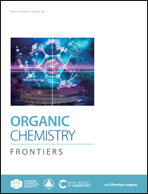N-heterocyclic nitrenium charge transfer catalysis via inner-sphere electron transfer in concert with halogen-atom dissociation†
Abstract
Visible light photoredox-catalyzed reactions have become essential tools in organic synthesis. However, these transformations often rely on high-cost photocatalysts that require multistep synthesis and chromophore design. In recent years, charge transfer complex (CTC) photochemistry has emerged as an alternative to photoredox catalysis, but this method requires substrates to form the CTC. To overcome these limitations, we developed a new catalytic paradigm using easily available N-heterocyclic nitreniums (NHNs) as photocatalysts. Our method uses incident light absorbed by the in situ-formed CTC between NHN and its counteranion or a sacrificial donor, extending CTC photochemistry to a general catalytic mode without relying on substrates. Here, we demonstrate NHN catalysis for the photoreduction of C–Cl bonds in chloroform and activated alkyl chlorides. This approach is characterized by easily available NHNs (one-step synthesis without column purification), operational simplicity, and diverse transformations. Mechanistic studies reveal that the generated NHN aminyl radical could undergo inner-sphere single-electron transfer in concert with halogen-atom dissociation.

- This article is part of the themed collection: 2023 Organic Chemistry Frontiers HOT articles


 Please wait while we load your content...
Please wait while we load your content...